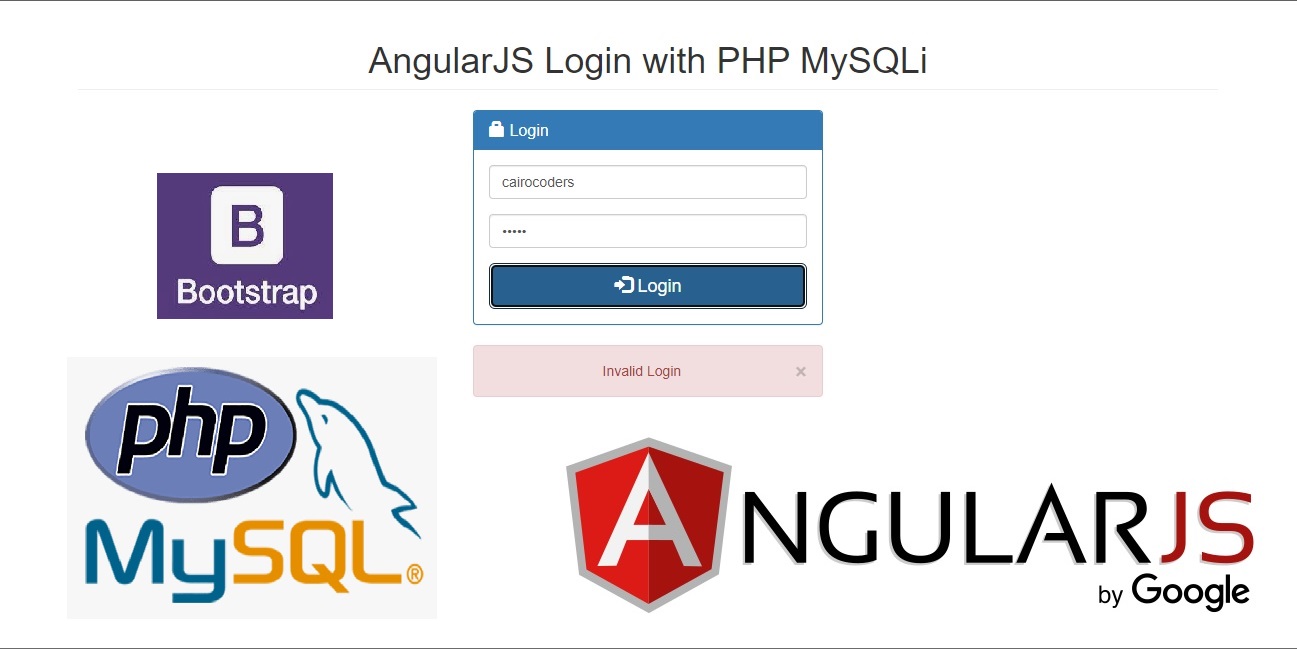This tutorial used CDN for Bootstrap, Angular JS and Angular Route
CREATE TABLE `tbl_user` (
`userid` int(11) NOT NULL,
`fullname` varchar(50) NOT NULL,
`username` varchar(100) NOT NULL,
`email` varchar(150) NOT NULL,
`password` varchar(150) NOT NULL
) ENGINE=MyISAM DEFAULT CHARSET=utf8;
INSERT INTO `tbl_user` (`userid`, `fullname`, `username`, `email`, `password`) VALUES
(1, 'cairocoder Ednalan', 'cairocoders', '', '123456'),
(2, 'tutorial101', 'tutorial101', '', '123456');
ALTER TABLE `tbl_user`
ADD PRIMARY KEY (`userid`);
ALTER TABLE `tbl_user`
MODIFY `userid` int(11) NOT NULL AUTO_INCREMENT, AUTO_INCREMENT=3;
index.html
//index.html <!DOCTYPE html> <html ng-app="app"> <head> <title>AngularJS Login with PHP MySQLi</title> <link href="https://maxcdn.bootstrapcdn.com/bootstrap/3.3.7/css/bootstrap.min.css" rel="stylesheet"> </head> <body> <div class="container"> <h1 class="page-header text-center">AngularJS Login with PHP MySQLi</h1> <div ng-view></div> </div> <script src="http://ajax.googleapis.com/ajax/libs/angularjs/1.4.8/angular.min.js"></script> <script src="http://ajax.googleapis.com/ajax/libs/angularjs/1.4.8/angular-route.min.js"></script> <script src="js/angular.js"></script> <script src="js/controllers/loginCtrl.js"></script> <script src="js/services/loginService.js"></script> </body> </html>login.html
//login.html
<div class="col-md-4 col-md-offset-4">
<div class="login-panel panel panel-primary">
<div class="panel-heading">
<h3 class="panel-title"><span class="glyphicon glyphicon-lock"></span> Login
</h3>
</div>
<div class="panel-body">
<form role="form" name="logform">
<fieldset> sdfsdfsf
<div class="form-group">
<input class="form-control" placeholder="Username" type="text" autofocus ng-model="user.username" required>
</div>
<div class="form-group">
<input class="form-control" placeholder="Password" type="password" ng-model="user.password" required>
</div>
<button type="button" id="loginbutton" class="btn btn-lg btn-primary btn-block" ng-disabled="logform.$invalid" ng-click="login(user)"><span class="glyphicon glyphicon-log-in"></span> <span id="logtext">Login</span></button>
</fieldset>
</form>
</div>
</div>
<div class="alert alert-danger text-center" ng-show="errorLogin">
<button type="button" class="close" ng-click="clearMsg()"><span aria-hidden="true">×</span></button>
{{ errorMsg }}
</div>
<div class="alert alert-success text-center" ng-show="successLogin">
<button type="button" class="close" ng-click="clearMsg()"><span aria-hidden="true">×</span></button>
{{ successMsg }}
</div>
</div>
angular.js
//angular.js
var app = angular.module('app', ['ngRoute']); //Routing - ngRoute module helps your application to become a Single Page Application.
app.config(function($routeProvider){
$routeProvider
.when('/', {
templateUrl: 'login.html',
controller: 'loginCtrl'
})
.when('/home', {
templateUrl: 'home.html'
})
.otherwise({
redirectTo: '/'
});
});
js/services/loginService.js
//js/services/loginService.js
'use strict';
app.factory('loginService', function($http){
return{
login: function(user, $scope){
var validate = $http.post('login.php', user);
validate.then(function(response){
if(response.data.error == true){
$scope.successLogin = false;
$scope.errorLogin = true;
$scope.errorMsg = response.data.message;
}
else{
$scope.errorLogin = false;
$scope.successLogin = true;
$scope.successMsg = response.data.message;
setTimeout(function(){
window.location.href="http://localhost/devtest/angularjs/angularlogin/#/home";
},2000);
}
});
}
}
});
js/controller/loginCtrl.js
//js/controller/loginCtrl.js
'use strict';
app.controller('loginCtrl', function($scope, loginService){
$scope.errorLogin = false;
$scope.successLogin = false;
$scope.login = function(user){
loginService.login(user, $scope);
}
$scope.clearMsg = function(){
$scope.errorLogin = false;
$scope.successLogin = false;
}
});
login.php
//login.php
<?php
$conn = new mysqli("localhost", "root", "", "testingdb");
if ($conn->connect_error) {
die("Connection failed: " . $conn->connect_error);
}
$out = array('error' => false);
$user = json_decode(file_get_contents('php://input'));
$username = $user->username;
$password = $user->password;
$sql = "SELECT * FROM tbl_user WHERE username='$username' AND password='$password'";
$query = $conn->query($sql);
if($query->num_rows>0){
$out['message'] = 'Login Successful';
}
else{
$out['error'] = true;
$out['message'] = 'Invalid Login';
}
echo json_encode($out);
?>











